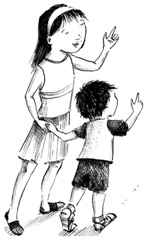Book Expo America has finished and Memorial Day is almost here, but in between, here’s your weekly batch of diversity reading!
Looking back to the era of Civil Rights protests and Civil Rights legislation, Breach of Peace presents some amazing portraits of some of the 1961 Freedom Riders—with their mugshots, recent interviews, and recent photos. Some amazing stories here. Meanwhile, an editorial at the Washington Post looks at the 1964 Civil Rights act and government support of private segregation.


 White Americans tend to raise children in nuclear families—just parents and kids—but in many cultures and many immigrant groups, extended families are deeply involved.
White Americans tend to raise children in nuclear families—just parents and kids—but in many cultures and many immigrant groups, extended families are deeply involved.